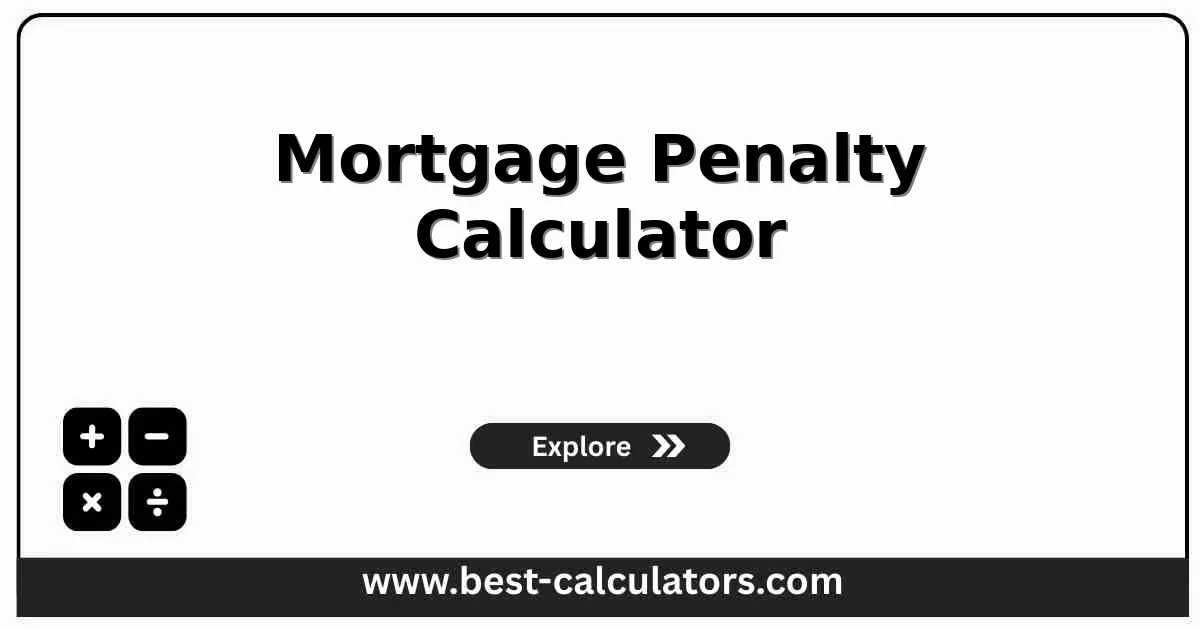Mortgage Penalty Calculator - Calculate Prepayment Fees
Free mortgage penalty calculator to estimate prepayment penalties and determine if early payoff or refinancing makes financial sense
Mortgage Penalty Calculator
Penalty Results
What is a Mortgage Penalty Calculator?
A mortgage penalty calculator is a free financial tool that estimates the prepayment penalties and fees you may incur when paying off your mortgage early, refinancing before term end, or breaking your mortgage contract. It helps you determine if early payoff is financially beneficial.
This calculator helps with:
- Refinancing decisions - Calculate penalty costs before switching lenders or rates
- Early payoff planning - Determine total cost to pay off mortgage before term ends
- Home sale preparation - Estimate penalties if selling before mortgage term expires
- Cost-benefit analysis - Compare penalty costs versus interest savings from refinancing
- Mortgage negotiation - Understand penalty structures when choosing mortgage terms
Before considering prepayment, use our mortgage payoff calculator to see how extra payments can reduce your loan term and interest costs without triggering penalties.
If you're considering refinancing, our refinance calculator can help you compare your current mortgage costs with new loan options to ensure refinancing benefits outweigh penalty costs.
For Canadian mortgages with IRD penalties, understanding your mortgage payment structure is essential for calculating the interest rate differential accurately.
How Mortgage Penalty Calculation Works
Mortgage penalties are calculated using three main methods:
1. Percentage of Balance
Penalty = Remaining Balance × Penalty %
Typically 1-2% of remaining balance. Example: $300,000 × 2% = $6,000
2. Months of Interest
Penalty = (Balance × Rate / 12) × Months
Usually 3-6 months of interest. Example: ($300,000 × 5% / 12) × 3 = $3,750
3. Interest Rate Differential (IRD)
IRD = (Current Rate - New Rate) × Balance × Months Left / 12
Common in Canada. Penalty based on interest rate difference over remaining term.
Key Penalty Concepts Explained
Prepayment Penalty
Fee charged by lenders when you pay off mortgage before the agreed term ends, compensating for lost interest income.
IRD Method
Interest Rate Differential calculates penalty based on the difference between your rate and current market rates.
Penalty Period
Timeframe when penalties apply, typically first 3-5 years of mortgage term or until rate lock period expires.
Prepayment Privilege
Allowed annual prepayment amount without penalty, usually 10-20% of original principal per year.
How to Use This Mortgage Penalty Calculator
Enter Remaining Balance
Input your current mortgage principal balance (e.g., $300,000)
Enter Current Rate
Input your mortgage interest rate (e.g., 5.5%)
Enter Months Remaining
Specify months left in your current term (e.g., 36 months)
Select Penalty Type
Choose percentage, months of interest, or IRD method
Enter Penalty Terms
Input percentage, number of months, or new rate as applicable
Calculate Penalty
Click Calculate to see total prepayment penalty cost
Benefits of Using Mortgage Penalty Calculator
- • Informed Decisions: Know exact penalty costs before committing to refinancing or early payoff.
- • Cost-Benefit Analysis: Compare penalty costs with potential interest savings from refinancing.
- • Refinancing Planning: Determine optimal timing for refinancing to minimize penalty impact.
- • Sale Preparation: Budget accurately for total mortgage payoff costs when selling property.
- • Negotiation Power: Understand penalty structures when negotiating mortgage terms with lenders.
- • Financial Planning: Factor penalty costs into overall homeownership and refinancing strategies.
Factors That Affect Your Penalty Costs
1. Penalty Calculation Method
IRD penalties often higher than percentage or months-of-interest methods. Check mortgage contract for specific terms.
2. Remaining Balance
Higher remaining balance = Higher penalty. Penalties decrease as you pay down principal over time.
3. Time Left in Term
More months remaining = Higher IRD penalty. Fixed-rate mortgages typically have higher penalties than variable.
4. Interest Rate Difference
For IRD, larger gap between your rate and current rates = Higher penalty. Falling rates increase penalties.
5. Lender-Specific Terms
Each lender calculates penalties differently. Some offer prepayment privileges or reduced penalty options.

Frequently Asked Questions
What is a mortgage prepayment penalty?
A mortgage prepayment penalty is a fee charged by lenders when you pay off your mortgage earlier than the agreed term. These penalties compensate lenders for lost interest income and are typically found in the first 3-5 years of a loan.
How is mortgage penalty calculated?
Mortgage penalties are typically calculated using one of three methods: a percentage of the remaining balance (usually 1-2%), a certain number of months' interest (commonly 6 months), or the interest rate differential (IRD) which compares your rate to current rates.
Can I avoid mortgage prepayment penalties?
You can avoid penalties by waiting until the penalty period expires, making only the allowed prepayment amount (typically 10-20% annually), or choosing a mortgage without prepayment penalties upfront, though these may have higher interest rates.
Are mortgage penalties tax deductible?
In some cases, mortgage prepayment penalties may be tax deductible if the mortgage is for a rental property or business. For primary residences, consult a tax professional as rules vary by jurisdiction and individual circumstances.
When do mortgage penalties apply?
Penalties typically apply when you pay off more than the allowed prepayment amount, refinance during the penalty period, sell your home before the term ends, or switch lenders before your term expires.